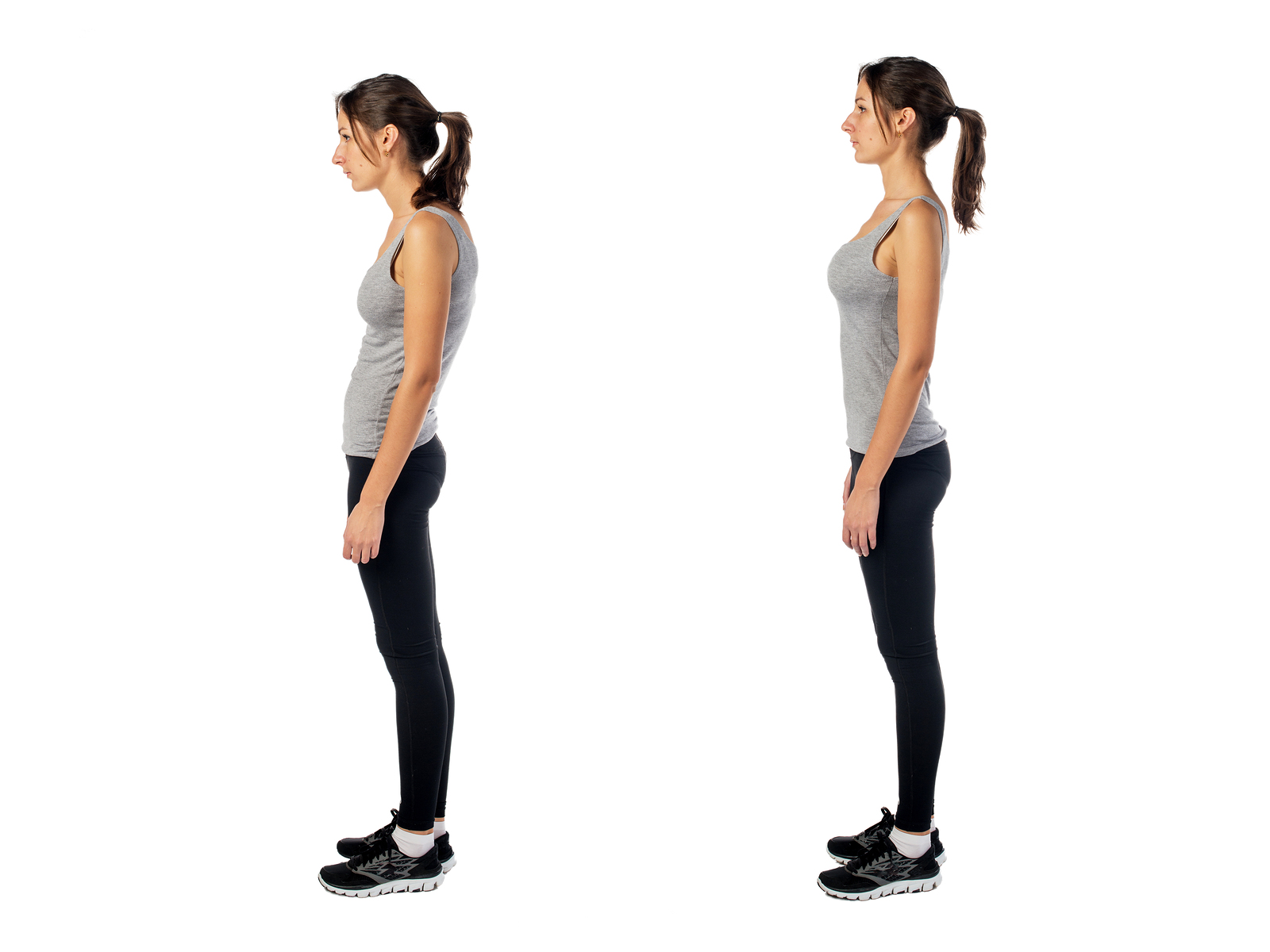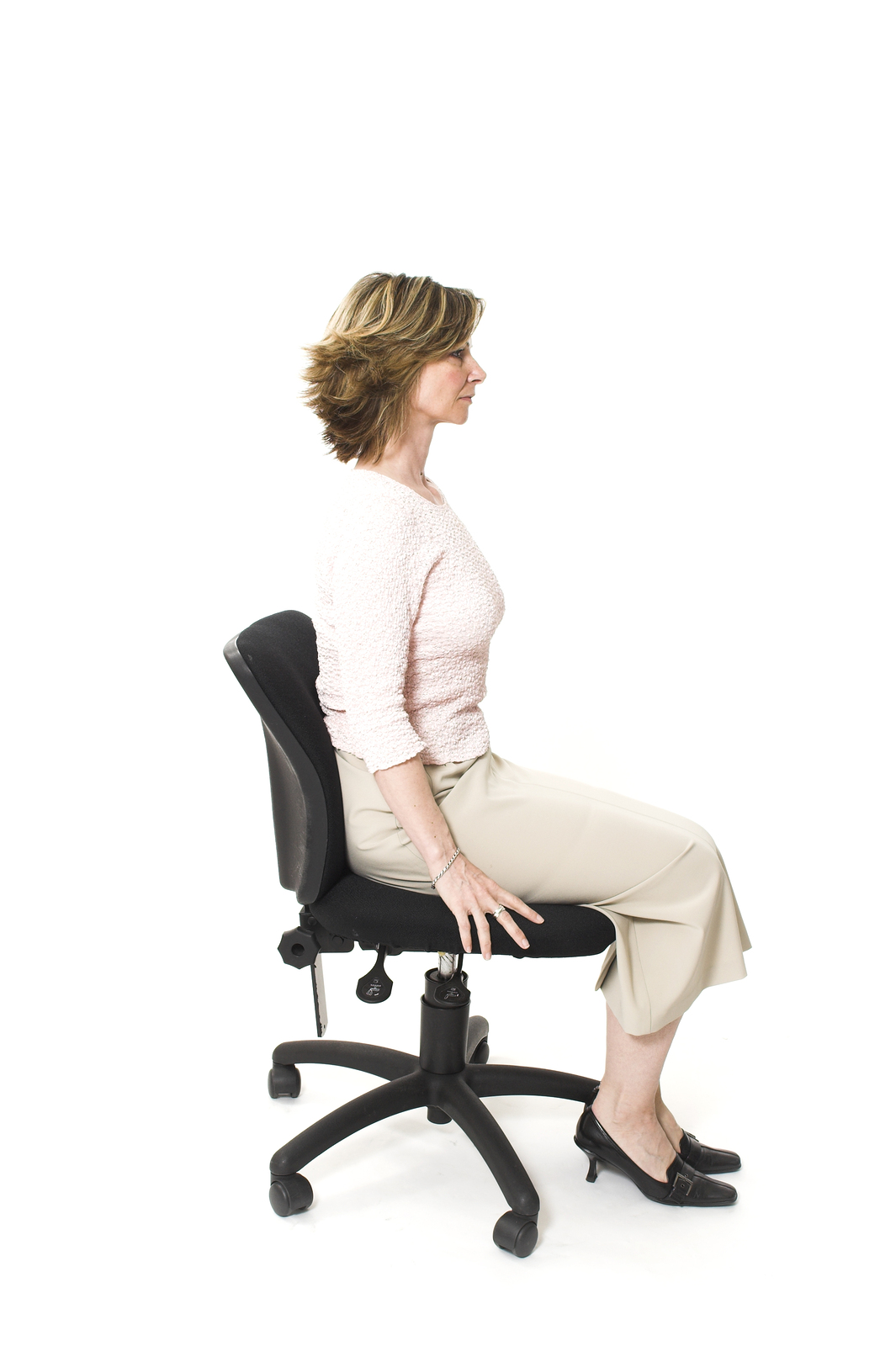Introduction
Welcome to The Cambridge Physiotherapy’s guide on the importance of posture.
Most likely everyone remembers somebody telling them when they were younger to ‘sit up straight!’ or ‘stop slouching!’ What is the big deal with slouching when it feels comfortable and is easy to do? And if you aren’t suppose to slouch, what is the optimal position to sit or stand in?

This article will discuss proper posturing and provide useful tips for you to avoid injury from poor positioning in sitting, standing and lying.
Posture, by definition, is the position in which our bodies are held when we sit, stand or lie down. Proper or good posturing means that we use the most efficient amount of muscle energy to keep our joints aligned against the downward pull of gravity. The least amount of strain is placed on our body when we are in a good posture. If our joints are not properly aligned in good posture, the force of gravity causes excess stress on parts of your joints as well as the ligaments that support them. Over the years, excess or imbalanced stress on a joint can lead to early stages of osteoarthritis. Your muscles have to use increased force and energy to work against the excess load, which causes the muscles and associated tendons to also become stressed. Other tissues such as fascia, nerves, blood vessels, and even your internal organs can also be affected by the added stress of poor posturing. Even the ability to breathe freely, deeply and maximally expand your lungs is affected by the position of your posture.
Everyone has ‘postural’ muscles that work (usually without you even knowing it!) to keep you upright against gravity. These muscles are constantly firing at low levels to keep you in position while standing or sitting. Examples of these muscles include deep muscles in the front of your neck, deep muscles in your back and abdominal area, and the deep calf muscle called the soleus.
 TRIAL: Stand still with your feet hip width apart. Even though you are virtually still, if you pay close attention, you will feel a mild sway of your body. You sway, but you don’t fall over. This is due to the way your postural muscles are hard at work to keep you upright! If you now drop your head right down towards your chest, you will experience the effects of gravity on your neck. You will feel the pull at the back of your neck and may even feel your muscles working harder to keep you from falling forward or from swaying more. This is an exaggerated position of poor posturing for your neck, but it demonstrates the increased stress you can feel on your joints and the increased work your muscles have to endure during a period of poor posturing.
TRIAL: Stand still with your feet hip width apart. Even though you are virtually still, if you pay close attention, you will feel a mild sway of your body. You sway, but you don’t fall over. This is due to the way your postural muscles are hard at work to keep you upright! If you now drop your head right down towards your chest, you will experience the effects of gravity on your neck. You will feel the pull at the back of your neck and may even feel your muscles working harder to keep you from falling forward or from swaying more. This is an exaggerated position of poor posturing for your neck, but it demonstrates the increased stress you can feel on your joints and the increased work your muscles have to endure during a period of poor posturing.
What is good posturing?
So what exactly is good posturing?
In order to correct your posture you must first be aware of your body and its current posture. Try each of the positions below first by standing, sitting or lying in your normal position and pay attention to the stresses, strains and comfortable areas you feel in your body. Then try each position taking the posture pointers below into consideration and note any changes you feel.
The most important posture points to remember when standing, sitting and lying are listed below, however, this list is neither exclusive nor tailored to suit your individual posture. For more specific posture pointers for your own body and everyday needs, you should consult your physiotherapist at The Cambridge Physiotherapy for a posture assessment.
Standing
 Standing is the hardest position to maintain a good posturing position in for a prolonged period simply because the entire body is unsupported and every joint and muscle has to work against gravity. Be mindful of the following points when trying to maintain good standing posture at any time but particularly if you need to stand for a prolonged period:
Standing is the hardest position to maintain a good posturing position in for a prolonged period simply because the entire body is unsupported and every joint and muscle has to work against gravity. Be mindful of the following points when trying to maintain good standing posture at any time but particularly if you need to stand for a prolonged period:
- Keep your head up in the neutral position. This means that your head doesn’t bend forwards or backwards and doesn’t tilt to one side. Imagine your chin sitting on a level platform. This position will keep your ear lobes in approximate alignment with the middle of your shoulder joint if you were to look at yourself from the side.
- Try to keep your shoulders pulled slightly backwards by using a very small amount of muscular tension in your upper back muscles. Do not let your shoulders round and slump forward as this pulls on your upper back, pushes your head forward out of alignment, and causes stress to the shoulder joint.
- Do not lock your knees backwards (hyperextend) but rather keep them in a relaxed position so the weight of your body falls over the middle of your knee joints.
- Keep your feet hip width apart and don't let your feet turn inwards or outwards too much.
- If you must stand for a prolonged period and are unable to take a break then shift your weight from one foot to the other or from your heels to your toes in order to change the distribution of your weight. You can also bend and straighten your knees a bit or put one foot slightly in front of the other. If feasible, try putting one foot up slightly onto something even as little as a thick book. Doing any of these things changes the position of your pelvis and hips and gives your tissues a break from the position they have just been maintaining.
Sitting

Sitting can be an easier position to maintain for a long period of time, but sitting can also cause a lot of stress to your body. Be mindful of the following points when trying to maintain good sitting posture at any time but particularly if you need to sit for a prolonged period:
- Keep your head in neutral position.
- Try to keep your shoulders pulled slightly.
- If you are working on a computer or at a desk, keep your forearms and wrists parallel to the ground. Do not let your wrists cock backwards while working.
- Move backwards to ensure your buttocks touch the back of the chair. If you are sitting at a desk or table you may then have to pull your chair closer in to the desk or table in order to maintain good posturing from the waist up. You should feel as though you are sitting on top of the bones in your buttocks, not rocking back behind them.
- Whenever possible use a chair with a backrest on it rather than a chair without one. If there is a choice in backrests, choose one that provides good support to your upper and lower back. You can also insert a back support if the chair back is inadequate, or in a pinch use a rolled up towel or something similar in the small of your back to help maintain and support the natural curve in this area.
- Ensure your thighs are roughly parallel to the ground. They may be slightly higher or lower depending on comfort and how well your chair can support your thighs.
- Ensure there is a space between the back of your knees and the chair in order to not cause pressure at the back of your calves. If you are too short to accomplish this, you may need to insert a back support behind you to bring you more forward in the chair or use a footrest.
- Do not cross your legs.

- Use a footrest whenever possible in order to keep your feet up at a slight angle and to maintain your thigh position. Keep your feet down flat on the footrest or floor if there is no footrest available.
- If you must sit for a long period and are unable to take a break then give your back a rest by tilting your pelvis forwards and backwards for a minute or two. If you are using a footrest change your position by taking one foot off of the footrest or if you aren’t using one then put something on the floor to put one foot up onto. By changing your foot position it changes the position of your pelvis and affects the pull on your tissues. Although it is not recommended for long periods, if you have to sit for an extended period then a brief period (less than 5 minutes) of crossing your legs either at your knees or with one ankle over the other knee will also change the position of your hips and pelvis and give a short rest to the tissues.
If you are an office worker or are required to sit for prolonged periods for your job then it is worthy to discuss your specific desk and sitting ergonomics with your physiotherapist. Whenever possible it is most beneficial to get advice while sitting at your actual workstation. Specific advice from your physiotherapist when purchasing a new office or work chair should also be sought.
Lying
Lying tends to be a very comfortable position for most people however lying in a poor position particularly for a long period can aggravate an existing injury or create a new injury. Be mindful of the following points when trying to maintain a good lying posture at any time but particularly when lying for a prolonged period such as during sleep or if bed rest is required to recover from an injury:
- Find a mattress that is just right for you. Generally a firmer mattress is better overall however many people find softer mattresses more comfortable for an existing injury. Whatever the mattress, ensure it is comfortable when lying both on your side and on your back.
- Avoid sleeping on your stomach as this requires extreme motion of the neck and puts the lower back into an overly arched position. If you must sleep on your stomach put a pillow or two under your hip area to avoid hyper extending your low back, and turn your head frequently from side to side to ease the pressure on your neck. Putting a pillow under your chest (along with the one under your hip area) can also decrease the stress on your neck when lying on your stomach.
- Avoid lying for prolonged positions on the couch or floor, which are not surfaces designed to support the weight of a lying body.
- Use a pillow to support your neck whether lying on your back or side and ensure it is not placed too low such that it tucks under your shoulders. Find a pillow that works for you; your neck should remain in a neutral or slightly forward-tilted position when on the pillow. The pillow should conform to the curvature of your neck in order to support it so a stiff pillow or one that cannot fill in the space of your neck curve is not recommended. Whether laying on your back or side pull the pillow in until you can feel it abut against your neck.
- When lying on your side, place a pillow (or two) between your legs. Make sure the support of the pillow extends from your inner thigh right down to your ankles and that the pillow is wide enough to fill in the natural space between your legs, which would be there if you were standing. Placing pillows between your legs helps to keep the spine in a more neutral position and also decreases the pressure you feel in your hips in this position.
- If you must lie for a prolonged position, other than for sleep, then use pillows as described above to take the stress off the body. Roll from side to side and onto your back periodically in order to change the tension that is put onto your tissues. If, for some reason, you need to remain on true bed rest for a long period where you are not allowed to be upright then it is worth consulting a physiotherapist as further individual advice needs to be provided for this unique situation. Special supports may be required to ensure the body does not develop injury from the prolonged lying position.
Any posture, whether good or bad, for a prolonged period of time, is actually tough on the body. Although as mentioned above there are certainly better posture positions that put less stress on your body, even remaining in these ‘good’ positions for too long puts strain on the body. For example, the soldier standing at proper attention can create injuries for themselves when they are required to do it for hours on end! Remember that even small adjustments in your position can change the activation of muscles and positively alter the stresses on your joints and other tissues. Thus although it is wise to maintain ‘proper’ posturing as often as possible, be sure to also remember that the body thrives on movement. Get up and out of a sustained posture position whenever possible!
What about braces and supports?
It is a common myth that using supports such as chairs, braces, special shoes or footrests is ‘cheating’ and not making your muscles work to support your body. This is definitely a myth! Even with a support your muscles must continue to work. It is often VERY useful to use specific supports to help sustain your posture. Anything that helps to keep your body in good alignment helps to teach your body what the best posturing position is and teaches the muscles exactly which forces are required. This is particularly true if you need to maintain one specific posturing such as standing or sitting for a prolonged period or if you are dealing with an injury. Braces and supports in these situations either allow your muscles to manage these positions for longer periods overall or allow them to manage these positions for longer periods without pain.
Your physiotherapist can advise you if there are any braces, supports, special chairs or shoes that would be good for your individual posture needs.
Conclusion
Maintaining a good position in standing, sitting and lying is something we should all strive to do whenever possible in order to decrease the overall stress on our bodies. Although it is impossible to maintain these perfect positions all of the time, remember that ‘it all counts’ when dealing with stress on the body, so try to put yourself in a good posture as often as possible. Apart from all the facts about good posture being better for your body, another truth is that proper posturing just simply makes you look better, look healthier and look (and hopefully feel) happier so….. stop slouching!
The Cambridge Physiotherapy provides services for physiotherapy in Cambridge, Galt, and Preston.

 TRIAL: Stand still with your feet hip width apart. Even though you are virtually still, if you pay close attention, you will feel a mild sway of your body. You sway, but you don’t fall over. This is due to the way your postural muscles are hard at work to keep you upright! If you now drop your head right down towards your chest, you will experience the effects of gravity on your neck. You will feel the pull at the back of your neck and may even feel your muscles working harder to keep you from falling forward or from swaying more. This is an exaggerated position of poor posturing for your neck, but it demonstrates the increased stress you can feel on your joints and the increased work your muscles have to endure during a period of poor posturing.
TRIAL: Stand still with your feet hip width apart. Even though you are virtually still, if you pay close attention, you will feel a mild sway of your body. You sway, but you don’t fall over. This is due to the way your postural muscles are hard at work to keep you upright! If you now drop your head right down towards your chest, you will experience the effects of gravity on your neck. You will feel the pull at the back of your neck and may even feel your muscles working harder to keep you from falling forward or from swaying more. This is an exaggerated position of poor posturing for your neck, but it demonstrates the increased stress you can feel on your joints and the increased work your muscles have to endure during a period of poor posturing. 








 Standing is the hardest position to maintain a good posturing position in for a prolonged period simply because the entire body is unsupported and every joint and muscle has to work against gravity. Be mindful of the following points when trying to maintain good standing posture at any time but particularly if you need to stand for a prolonged period:
Standing is the hardest position to maintain a good posturing position in for a prolonged period simply because the entire body is unsupported and every joint and muscle has to work against gravity. Be mindful of the following points when trying to maintain good standing posture at any time but particularly if you need to stand for a prolonged period:


